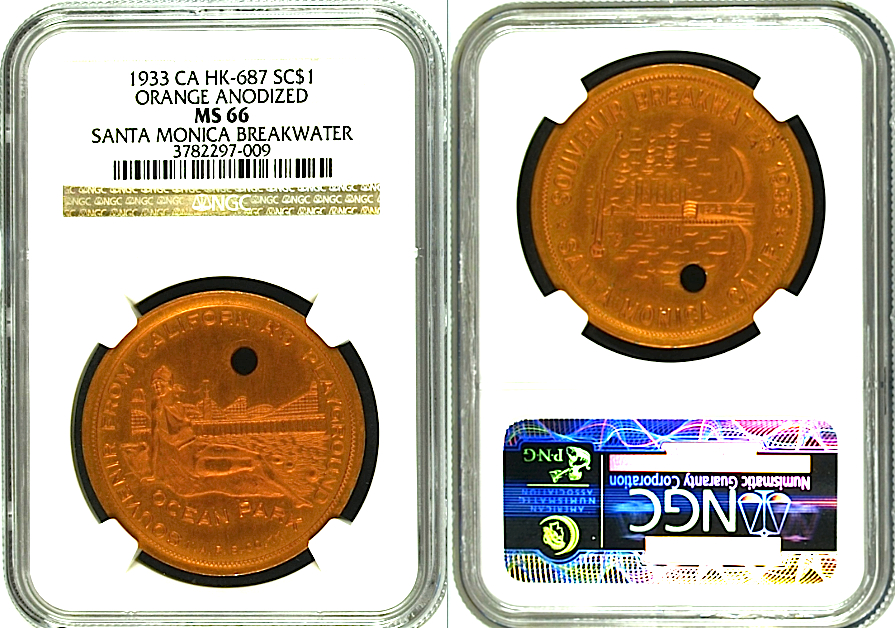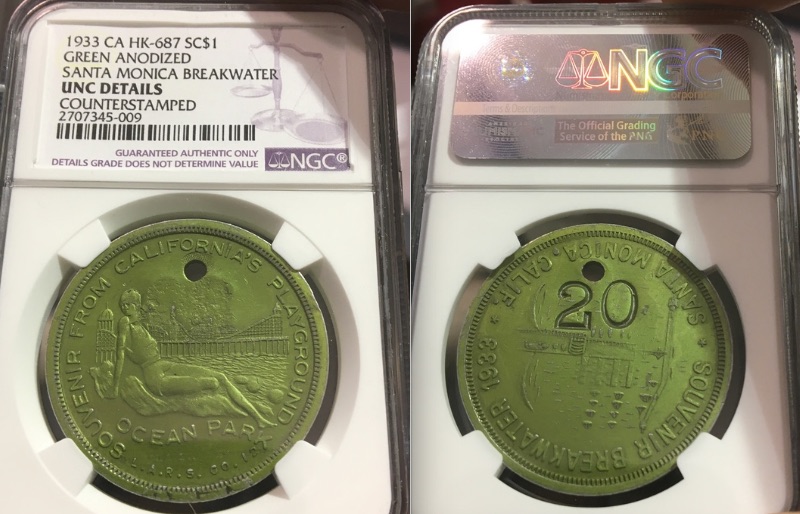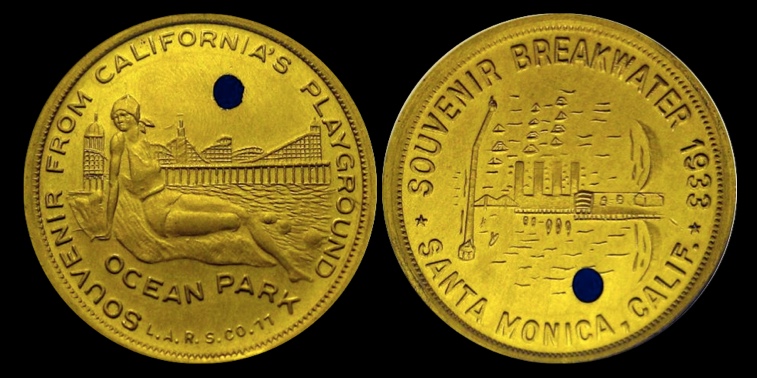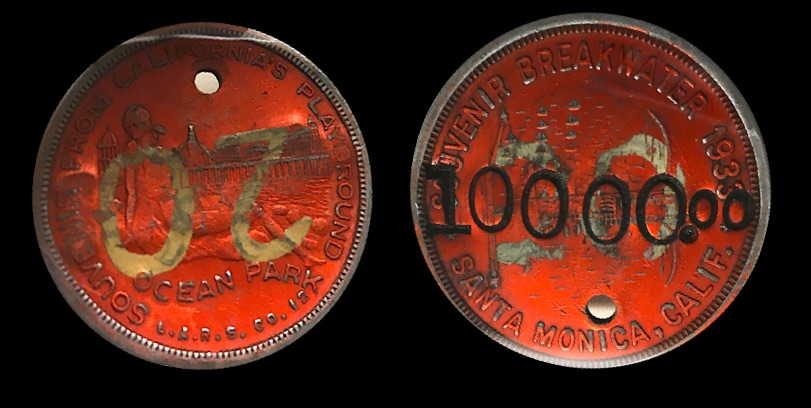So-Called Dollar Discussions
Santa Monica Breakwater HK-680 to HK-687 Colors/Variations
Quote from Pioneer on June 26, 2013, 7:21 pmI thought i'd post some of the color anodized pieces. From what I understand, the colors include blue (most common), orange, yellow, green, and red (rare). I've seen a red one in person (thanks to Duane Feizel). I've also seen some of the bi-metallic SCD pieces (and other ad tokens) made by the Los Angeles Rubber Stamp Co (L.A.R.S. Co). I'm not sure that anyone really knows what the numbers at the bottom of the obverse (after L.A.R.S. Co) mean or signify, but it would be interesting to see a table or rarities on the numbers. An interesting discussion on the bimetallics is at http://forums.collectors.com/messageview.cfm?catid=26&threadid=876724
These may have been made as arcade tokens. The different colors perhaps could have been used for different prize levels. The numbers on some of them, painted or stamped, must have been added later for another purpose. An anodized token at the time would have been a novelty, so maybe the makers were thinking that many people would take them home as souvenirs, thus they could make money off them both as a usable arcade token or as a souvenir.
The holed pieces are a mystery though. They all have holes, so they must have all been made that way for a specific purpose in mind. It appears that they were punched into the obverse field so as not to damage the design or lettering. Maybe the intent was to have them worn on a necklace or whatever so that they would not be dropped as easily and lost through the cracks of the Santa Monica Pier boardwalk. The problem with that theory is that I have never seen any of them come with an attached string, or any other attachment for that matter. Maybe the holes were never used as the makers first intended. I went on the internet to see if I could find historical reasons for holed tokens. There is a South African money token that was made by Stranger and Co. that was holed so that the natives could wear them around their neck along with their beads. The natives had a name for the sound that they made when they clinked together. I guess other African coins are also holed for similar reasons. Anyway, I wonder if there is still an old timer somewhere who knows the truth. It also bothers me that these tokens are not mentioned in HK. Were they minted after 1962? And why were the dies numbered? These tokens must have an interesting history. If only coins could talk.
I thought i'd post some of the color anodized pieces. From what I understand, the colors include blue (most common), orange, yellow, green, and red (rare). I've seen a red one in person (thanks to Duane Feizel). I've also seen some of the bi-metallic SCD pieces (and other ad tokens) made by the Los Angeles Rubber Stamp Co (L.A.R.S. Co). I'm not sure that anyone really knows what the numbers at the bottom of the obverse (after L.A.R.S. Co) mean or signify, but it would be interesting to see a table or rarities on the numbers. An interesting discussion on the bimetallics is at http://forums.collectors.com/messageview.cfm?catid=26&threadid=876724
These may have been made as arcade tokens. The different colors perhaps could have been used for different prize levels. The numbers on some of them, painted or stamped, must have been added later for another purpose. An anodized token at the time would have been a novelty, so maybe the makers were thinking that many people would take them home as souvenirs, thus they could make money off them both as a usable arcade token or as a souvenir.
The holed pieces are a mystery though. They all have holes, so they must have all been made that way for a specific purpose in mind. It appears that they were punched into the obverse field so as not to damage the design or lettering. Maybe the intent was to have them worn on a necklace or whatever so that they would not be dropped as easily and lost through the cracks of the Santa Monica Pier boardwalk. The problem with that theory is that I have never seen any of them come with an attached string, or any other attachment for that matter. Maybe the holes were never used as the makers first intended. I went on the internet to see if I could find historical reasons for holed tokens. There is a South African money token that was made by Stranger and Co. that was holed so that the natives could wear them around their neck along with their beads. The natives had a name for the sound that they made when they clinked together. I guess other African coins are also holed for similar reasons. Anyway, I wonder if there is still an old timer somewhere who knows the truth. It also bothers me that these tokens are not mentioned in HK. Were they minted after 1962? And why were the dies numbered? These tokens must have an interesting history. If only coins could talk.
Quote from Pioneer on March 2, 2014, 9:04 pmTo answer my own question, here is a yellow anodized NGC MS-65 sold in Steve Hayden's recent auction.
To answer my own question, here is a yellow anodized NGC MS-65 sold in Steve Hayden's recent auction.
Uploaded files:Quote from Pioneer on March 26, 2014, 5:32 pmHere are images of the red one mentioned above (images courtesy of Duane Feisel). Not sure what the alterations are all about.
Here are images of the red one mentioned above (images courtesy of Duane Feisel). Not sure what the alterations are all about.
Uploaded files:Quote from Bill Walter on September 9, 2014, 12:53 pmHi Bob. Always appreciate your posts. I bought the green HK687 on eBay. Over the years I've heard three ideas as to the stamped/painted numbers: used as part of an arcade game, locker tags, and now poker chips (your suggestion). On a different but related note, many folks are aware of the recent eBay offerings for yellow and orange HK687s in nice condition. A few weeks ago the original seller relayed some useful information to me. He stated that several decades ago he bought small hoards of both colors in unc condition (about 100 yellow and about 20 orange). I'm sharing that info here because it might help SCD collectors rethink what yellow and orange anodized pieces should sell for in the future.
I guess this piece comes in green.... hadn't seen that color until the attached one sold on eBay in July 2015. Congrats to the winner (not me). I am thinking that the stamped numbers (not the tiny L.A.R.S. numbers) make them like poker chips or the likes...
Hi Bob. Always appreciate your posts. I bought the green HK687 on eBay. Over the years I've heard three ideas as to the stamped/painted numbers: used as part of an arcade game, locker tags, and now poker chips (your suggestion). On a different but related note, many folks are aware of the recent eBay offerings for yellow and orange HK687s in nice condition. A few weeks ago the original seller relayed some useful information to me. He stated that several decades ago he bought small hoards of both colors in unc condition (about 100 yellow and about 20 orange). I'm sharing that info here because it might help SCD collectors rethink what yellow and orange anodized pieces should sell for in the future.
I guess this piece comes in green.... hadn't seen that color until the attached one sold on eBay in July 2015. Congrats to the winner (not me). I am thinking that the stamped numbers (not the tiny L.A.R.S. numbers) make them like poker chips or the likes...
Quote from billycgribble on September 9, 2014, 10:34 pmI think that the blue anodized pieces have always been fairly common, I remember 10 to 20 years ago seeing dealers with 5 to 10 of them. I have never seen one without a hole and they almost always are found very nice.
I think that the blue anodized pieces have always been fairly common, I remember 10 to 20 years ago seeing dealers with 5 to 10 of them. I have never seen one without a hole and they almost always are found very nice.
Quote from Pioneer on July 27, 2015, 8:22 pmThought i'd post this HK-684 here. Interesting discussion about these pieces at: http://forums.collectors.com/messageview.cfm?catid=26&threadid=876724&STARTPAGE=1
Thought i'd post this HK-684 here. Interesting discussion about these pieces at: http://forums.collectors.com/messageview.cfm?catid=26&threadid=876724&STARTPAGE=1
Quote from goldincoin on August 27, 2015, 2:11 pmI guess this piece comes in green.... hadn't seen that color until the attached one sold on eBay in July 2015. Congrats to the winner (not me). I am thinking that the stamped numbers (not the tiny L.A.R.S. numbers) make them like poker chips or the likes...
I guess this piece comes in green.... hadn't seen that color until the attached one sold on eBay in July 2015. Congrats to the winner (not me). I am thinking that the stamped numbers (not the tiny L.A.R.S. numbers) make them like poker chips or the likes...
Quote from jraymond on September 2, 2015, 3:02 pmI know these are suppose to be dedication medals but I've always wondered if these were used on the Santa Monica carnival/boardwalk and thought of the possibility of these being used for levels of stuffed animals, carnival glass, souvenir memento's etc or to denote different point levels when being milked by a good carny game person.
Sorry Im so late in posting here. I picked these up on ebay in 2004. At one time I thought maybe they were used at a hotel for room numbers attached to key rings or whatever, but that pretty much is out of the question being the number 20 was used more than once. They may have been used as gambling chips I suppose, but they would probably need a lot of them. The blue and the red ones have counterstamps on them that look as if they were done sometime after the painted numbers. Like Rjessinger's red one above, my red one also has 10000.00 on it. Note how the ?1? on my piece is doubled, but the rest of the numbers are not doubled. The blue one just has a ?10? on it. If they were used as gambling chips, the number 10000.00, if it in fact means $10000, seems like a pretty big number for a homemade poker chip. Maybe they were used outside of the US for some inflated currency. But if that were the case, would they even bother to have a $10 chip? Maybe I guess. It is good to see all of the others for comparison that everyone else has posted. Sort of adds even more to the mystery though. It would be nice to find pieces with 5, 50, 100, 500 and 1,000 stamped on them. Are there some other gambling games besides poker that they could have been used for? Some Oriental game perhaps? Just a thought. I have no idea.
I know these are suppose to be dedication medals but I've always wondered if these were used on the Santa Monica carnival/boardwalk and thought of the possibility of these being used for levels of stuffed animals, carnival glass, souvenir memento's etc or to denote different point levels when being milked by a good carny game person.
Sorry Im so late in posting here. I picked these up on ebay in 2004. At one time I thought maybe they were used at a hotel for room numbers attached to key rings or whatever, but that pretty much is out of the question being the number 20 was used more than once. They may have been used as gambling chips I suppose, but they would probably need a lot of them. The blue and the red ones have counterstamps on them that look as if they were done sometime after the painted numbers. Like Rjessinger's red one above, my red one also has 10000.00 on it. Note how the ?1? on my piece is doubled, but the rest of the numbers are not doubled. The blue one just has a ?10? on it. If they were used as gambling chips, the number 10000.00, if it in fact means $10000, seems like a pretty big number for a homemade poker chip. Maybe they were used outside of the US for some inflated currency. But if that were the case, would they even bother to have a $10 chip? Maybe I guess. It is good to see all of the others for comparison that everyone else has posted. Sort of adds even more to the mystery though. It would be nice to find pieces with 5, 50, 100, 500 and 1,000 stamped on them. Are there some other gambling games besides poker that they could have been used for? Some Oriental game perhaps? Just a thought. I have no idea.
Quote from billycgribble on September 2, 2015, 5:51 pmAccording to HK no one has figured out the meaning of the numbers. They also state that 6 obverse dies are known with no corrolation the the numbers. I ask the question that each of the number of 1-14 would be a different die or does it mean that a die had the numbers changed? One last comment. Every blue anodized piece that I have ever seen have the number of 11.
Seems like something up with the blue ones. I saw maybe three in 10+ years and nothing fantastic as to grade and never purchased one. Now I think I've seen 14 in the last 4months and almost all fantastic grades with full coloring. Question though-- does anyone have a blue one that doesn't have a hole in it for hanging on a peg? Appears a small hoard must have been discovered. Realistically I think the value of this piece in high grade has been halved in the last 60 days and might get down to the lower prices of the commonest of these pieces. and except for the blue ones most are not holed.
According to HK no one has figured out the meaning of the numbers. They also state that 6 obverse dies are known with no corrolation the the numbers. I ask the question that each of the number of 1-14 would be a different die or does it mean that a die had the numbers changed? One last comment. Every blue anodized piece that I have ever seen have the number of 11.
Seems like something up with the blue ones. I saw maybe three in 10+ years and nothing fantastic as to grade and never purchased one. Now I think I've seen 14 in the last 4months and almost all fantastic grades with full coloring. Question though-- does anyone have a blue one that doesn't have a hole in it for hanging on a peg? Appears a small hoard must have been discovered. Realistically I think the value of this piece in high grade has been halved in the last 60 days and might get down to the lower prices of the commonest of these pieces. and except for the blue ones most are not holed.



